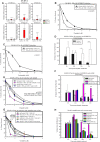APOBEC3 enzymes mediate efficacy of cisplatin and are epistatic with base excision repair and mismatch repair in platinum response
- PMID: 33196045
- PMCID: PMC7646253
- DOI: 10.1093/narcan/zcaa033
APOBEC3 enzymes mediate efficacy of cisplatin and are epistatic with base excision repair and mismatch repair in platinum response
Abstract
Identifying the mechanisms mediating cisplatin response is essential for improving patient response. Previous research has identified base excision repair (BER) and mismatch repair (MMR) activity in sensitizing cells to cisplatin. Cisplatin forms DNA adducts including interstrand cross-links (ICLs) that distort the DNA helix, forcing adjacent cytosines to become extrahelical. These extrahelical cytosines provide a substrate for cytosine deaminases. Herein, we show that APOBEC3 (A3) enzymes are capable of deaminating the extrahelical cytosines to uracils and sensitizing breast cancer cells to cisplatin. Knockdown of A3s results in resistance to cisplatin and induction of A3 expression in cells with low A3 expression increases sensitivity to cisplatin. We show that the actions of A3s are epistatic with BER and MMR. We propose that A3-induced cytosine deamination to uracil at cisplatin ICLs results in repair of uracils by BER, which blocks ICL DNA repair and enhances cisplatin efficacy and improves breast cancer outcomes.
© The Author(s) 2020. Published by Oxford University Press on behalf of NAR Cancer.
Figures





References
Grants and funding
LinkOut - more resources
Full Text Sources

